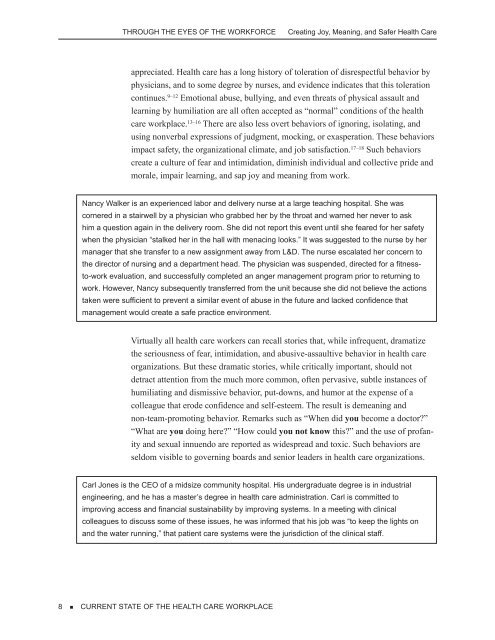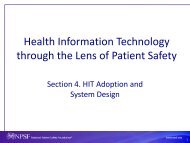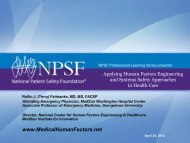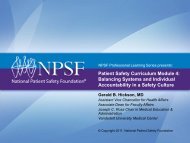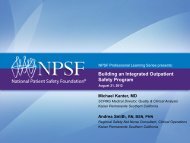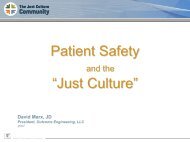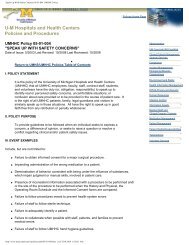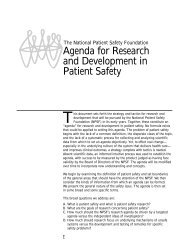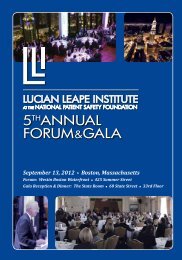Through The eyes of The Workforce - National Patient Safety ...
Through The eyes of The Workforce - National Patient Safety ...
Through The eyes of The Workforce - National Patient Safety ...
Create successful ePaper yourself
Turn your PDF publications into a flip-book with our unique Google optimized e-Paper software.
THROUGH THE EYES OF THE WORKFORCECreating Joy, Meaning, and Safer Health Careappreciated. Health care has a long history <strong>of</strong> toleration <strong>of</strong> disrespectful behavior byphysicians, and to some degree by nurses, and evidence indicates that this tolerationcontinues. 9–12 Emotional abuse, bullying, and even threats <strong>of</strong> physical assault andlearning by humiliation are all <strong>of</strong>ten accepted as “normal” conditions <strong>of</strong> the healthcare workplace. 13–16 <strong>The</strong>re are also less overt behaviors <strong>of</strong> ignoring, isolating, andusing nonverbal expressions <strong>of</strong> judgment, mocking, or exasperation. <strong>The</strong>se behaviorsimpact safety, the organizational climate, and job satisfaction. 17–18 Such behaviorscreate a culture <strong>of</strong> fear and intimidation, diminish individual and collective pride andmorale, impair learning, and sap joy and meaning from work.Nancy Walker is an experienced labor and delivery nurse at a large teaching hospital. She wascornered in a stairwell by a physician who grabbed her by the throat and warned her never to askhim a question again in the delivery room. She did not report this event until she feared for her safetywhen the physician “stalked her in the hall with menacing looks.” It was suggested to the nurse by hermanager that she transfer to a new assignment away from L&D. <strong>The</strong> nurse escalated her concern tothe director <strong>of</strong> nursing and a department head. <strong>The</strong> physician was suspended, directed for a fitnessto-workevaluation, and successfully completed an anger management program prior to returning towork. However, Nancy subsequently transferred from the unit because she did not believe the actionstaken were sufficient to prevent a similar event <strong>of</strong> abuse in the future and lacked confidence thatmanagement would create a safe practice environment.Virtually all health care workers can recall stories that, while infrequent, dramatizethe seriousness <strong>of</strong> fear, intimidation, and abusive-assaultive behavior in health careorganizations. But these dramatic stories, while critically important, should notdetract attention from the much more common, <strong>of</strong>ten pervasive, subtle instances <strong>of</strong>humiliating and dismissive behavior, put-downs, and humor at the expense <strong>of</strong> acolleague that erode confidence and self-esteem. <strong>The</strong> result is demeaning andnon-team-promoting behavior. Remarks such as “When did you become a doctor?”“What are you doing here?” “How could you not know this?” and the use <strong>of</strong> pr<strong>of</strong>anityand sexual innuendo are reported as widespread and toxic. Such behaviors areseldom visible to governing boards and senior leaders in health care organizations.Carl Jones is the CEO <strong>of</strong> a midsize community hospital. His undergraduate degree is in industrialengineering, and he has a master’s degree in health care administration. Carl is committed toimproving access and financial sustainability by improving systems. In a meeting with clinicalcolleagues to discuss some <strong>of</strong> these issues, he was informed that his job was “to keep the lights onand the water running,” that patient care systems were the jurisdiction <strong>of</strong> the clinical staff.8 • CURRENT STATE OF THE HEALTH CARE WORKPLACE


